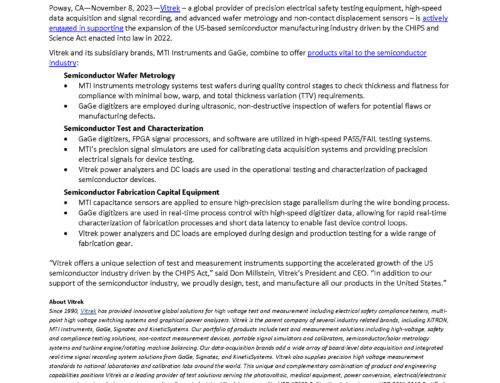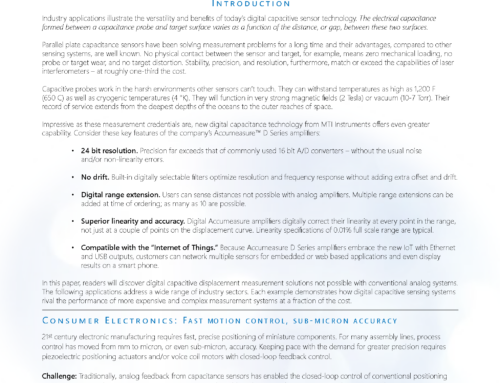Capacitance Sensors Track Brake Rotor Thickness Variation
Description
[Application Note 51018]
Today’s cars and trucks offer unprecedented fuel efficiencies and handling characteristics – thanks, in part, to vehicle lightweighting. Applied to all vehicle components, lightweighting lowers stress and strain to improve mileage and boost overall performance.
In keeping with this trend, today’s brake rotors are thinner and lighter than those of just a few years ago. In addition, many feature cooling vents to further improve performance. These changes, however, reduce available braking surface, forcing automotive engineers to consider alternative materials and designs.
Problem
Because the extreme temperatures and forces generated during braking can easily lead to rotor distortion and failure, in-vehicle testing of any new design is mandatory. Data on rotor runout, thickness variation, coning or warping, and temperature must be continuously collected to evaluate how prototype units respond to real-life conditions.
Likewise, inconsistencies in the manufacturing process can introduce thickness variation and runout. Brake rotor measurements must also be monitored during the production process.
Solution
MTI’s newest multi-channel brake rotor measurement system, the Accumeasure D Series, satisfies the requirements of both test scenarios. The amplifier uses advanced technology to change a reliable capacitive electric field measurement into a highly accurate 24-bit digital reading. This eliminates errors related to analog filtering, linearization, range extension, and the analog summing of channels.

MTI‚Äôs Accumeasure™ D Series amplifier provides up to four independent measurement channels in a rugged, compact amplifier package. MTI also offers an analog 500 series Rack system with AS563 Probe Amplifiers. This system works with high-temperature probes and offers a 12VDC option as well as 120VAC.
Capacitance displacement probes monitor the gap between the probe and rotor surface. As many as three probes can be placed on the holder for more accurate rotor mapping. Made from Inconel and ceramic materials, the non-contacting probes withstand temperatures reaching 1200° F (650°C).
If the rotor grounding is poor or non-existent, MTI’s Push-Pull probes can be used to make the measurements. Two sensing elements built into one probe body eliminate the need to electrically ground the rotor.

Non-contact capacitance displacement sensors monitor the distance between the probes and spinning rotor. As many as three probes can be placed on the holder for better results and more accurate rotor mapping.
Benefits
MTI‚Äôs Accumeasure™ D Series amplifier features multiple unit synchronization, range extension, sub-micron resolution, and 0.01% FSR linearity. With Digital Accumeasure software, data can be displayed on a laptop or saved to CSV file for further data reduction.
In addition to brake testing, the digital capacitance amplifier can be used to measure and monitor spindle and shaft runout, engine vibration, thermal expansion/contraction, and suspension travel.
MTI‚Äôs Accumeasure™ D Series amplifier provides up to four independent measurement channels in a rugged, compact amplifier package. MTI also offers an analog 500 series Rack system with AS563 Probe Amplifiers. This system works with high-temperature probes and offers a 12VDC option as well as 120VAC.

Leading vehicle manufacturers have standardized on MTI‚Äôs Accumeasure high-temperature sensors and the Accumeasure™ D Series amplifier for their testing requirements. This photo shows opposing probes in a fixture which straddles the rotor.



